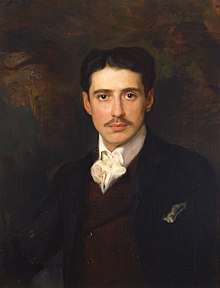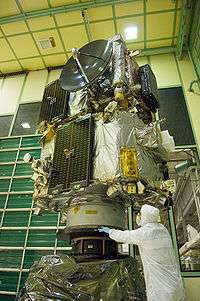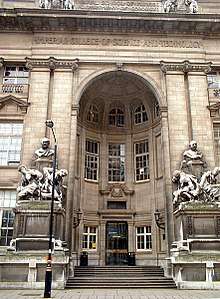École supérieure d'optique
The Institut d'optique Graduate School ("Institute of optics"), nicknamed "SupOptique" or "IOGS", is one of the most prestigious French Grandes Ecoles and the leading French grande école in the field of optics and its industrial and scientific applications, and a graduate school of the prestigious Paris-Saclay University,[2] and ParisTech.
 | |
| Type | Grande école |
|---|---|
| Established | 1917 |
Parent institution | Paris-Saclay University |
| President | Elisabeth Giacobino |
| Director | Jean-Louis Martin |
Academic staff | 50 |
Administrative staff | 200 |
| Students | 600[1] (400 in MScEng, 50 in MSc, 150 in PhD) |
| Postgraduates | 450 |
| 150 | |
| Address | 2 avenue Augustin Fresnel, Palaiseau , Paris-Saclay (Palaiseau & Orsay), Saint-Etienne, Bordeaux , France |
| Campus | Campus Paris-Saclay |
| Nickname | SupOptique |
| Affiliations | ParisTech |
| Website | www.institutoptique.fr |
The École supérieure d'optique was opened in 1920, as part of the Institut d'optique théorique et appliquée, aiming to train engineers and cadres for the French optics industry. It is consequently the oldest institution of higher education and research in optics in the world [3] and the most important in term of annual number of graduates.
The Institut d'optique Graduate School provides an education of high scientific level, specially for former students from the French Classe préparatoire aux grandes écoles. It trains engineers to be, in industry and research, the actors of the development of optics in many areas such as telecommunications, biology, energy, materials, nanotechnologies, aerospace engineering. It trains also researchers and teachers in the fields of optics and physics. Through the Institut d'optique théorique et appliquée, it participates at the world level to the promotion of knowledges and to the development of new techniques in optics
Since September 2006, the set constituted by the École supérieure d'optique and the Institut d'optique théorique et appliquée has been designated by the names "Institut d'optique Graduate School" or Institut d'optique.

History
Project & Creation

Armand de Gramont who was a rich industrialist and friend of Marcel Proust, is the man who first initiated the will to create the Institut d'Optique. In 1916, Gramont and Henri Chrétien (a French astronomer) were working together at the French Technical Aeronautics Section. Chrétien was working at the time on calculations for optical instruments. They both decided to create the project of building an institute dedicated to teaching Optics. That same year, Gramont became part of a comity that examined inventions that could interest the ministry of Defense. That is where he met Charles Fabry, who had previously become famous thanks to his experimental demonstration of the existence of the Ozone layer in the atmosphere. On October 21, 1916 Gramont had lunch with four government ministers. As a result, a new committee was formed, in charge of establishing the project. During the month of November 1917, the first board meeting was held.
Academics
A number of noted French optical scientists have been associated with SupOptique, including Henri Chrétien, Charles Fabry, André Maréchal, and Alain Aspect.
As of 2006 the school had 50 permanent faculty members (teachers, teacher-researchers and researchers), 241 students in the "diplôme d'ingénieur de l'ESO" programme, 15 students in the national research master programme (some of them matriculated in the université Paris-XI or another institution) and 40 doctoral students (matriculated in the université Paris-XI).
Admission & Engineer's degree
Like most grandes écoles in France, students have to follow a two or three-year intensive preparation in a "classe préparatoire aux grandes écoles" (CPGE) before entering the school after having sat a competitive entrance exam. If selected, students can then follow the three-year course. For those undergraduate students, the engineer's degree of the school (diplôme d'ingénieur de l'École supérieure d'optique) is a first degree. About 10 graduate students enter also the first or second year of the engineer's degree programme after sitting an entrance exam.
The course lasts for three years. Students have the possibility, during the second year, of taking part in the "apprentissage" which consists of a partnership between the school and a company. The student will thus follow part of the studies at the school and will work at the company the rest of the time.
It is possible to follow courses abroad in universities that have partnerships with the school (such as Imperial College or Cambridge University for instance) for the entire year. Students can also choose to do their second and third years a special branch of the school located in Saint-Étienne or since 2012 at Bordeaux.
The first year consists of fundamental physics and engineering sciences (820 hours). At the end of year one, students must do a one-month internship. Year two is centered around optical components (720 hours) and ends with a two-month internship. And finally, during year three, students must choose amongst a variety of specialities and learn how to integrate optical technologies to systems.
Teachings
- Year One
Mathematics (Signal Processing, Probability & Noise), Geometric Optics, Physical Optics, Polarization, Electronics (Anologue & Digital), Computer Sciences (numerical analysis and C programming), Quantum Mechanics, Atomic Physics, Semiconductors, Electromagnetism, Microproessors, Engineering Sciences (Automatics), Practicals (Optics & Electronics), Communication, English, Second Language (Spanish, German, Swedish, Chinese, Japanese)
- Year Two
Lasers, Fourier Optics, Aberrations & Diffraction, Radiometry, Detection Systems, Optical Design, Computer Sciences (C language), Laser Diodes, Electro & Acousto-Optics, Waveguided Optics, Non-Linear Optics, Holography, Statistical Optics, Interaction Light-Matter, Statistical Physics, Biophotonics, Electronics (Commutation & High Frequencies, Practicals (Optics & Electronics), project work, English, Second Language, Innovation in Science & Engineering, Company Economy
- Year Three
3 specialities to choose from: Laser Technology, Signal Processing applied to Imaging, Non-Linear Electromagnetism, Optronics, Telecommunications, Computer Sciences (C++ language)
3 specialities to choose from: Imaging, Opto-Electronic components, Micro-Optics, Turbulence Imaging, Near Field Microscopy, Nanophotonics, Plasma, Computer Sciences (Optical Design Software), Micro-fabrication, Radar, Economy courses at the HEC school in Paris
3 specialities to choose from: Opto-Mechanical Surfaces, Bio-Physics, Bio-Photonics, Visualization, Quantum Optics, Pattern Recognition, Optical Sensors, Photometric Engineering, HEC courses
Compulsory subjects: English, Project Management, Company & Contract Law, Patents, Project Work (20–30 days)
Post-graduate studies
Graduates from a university (with a French diploma or degree "DUT", "BTS", "licence", "master" or a foreign degree) can be admitted in the first or second year of the "diplôme d'ingénieur de l'ESO" programme. Graduates from the École polytechnique and from the École normale supérieure Paris-Saclay can be admitted in the fifth years of this programme.
The Institut d'optique Graduate School organizes also a national research master programme in two years (diplôme national de master en sciences et technologie à finalité de recherche mention physique et applications spécialité optique, matière et plasma) for graduate students with a licence or an equivalent foreign degree. Students in the "diplôme d'ingénieur de l'ESO" programme have also access to this programme. A doctorate in optics can be prepared in the internationally recognized research laboratory of Institut d'optique, the Laboratoire Charles Fabry, the doctor's degree is awarded by the Université Paris-Sud or the École polytechnique.
Research
Research teams & activities

Most research groups are part of the Charles Fabry Laboratory since 1998, which is associated to the CNRS and the Université Paris-Sud. Pierre Chavel is the director of the laboratory.
Here are the different research groups of the laboratory (2005):
- Atom optics group (head: Alain Aspect)
- Quantum optics group (head: Philippe Grangier)
- Nanophotonics & Electromagnetism group (head: Henri Benisty & Philippe Lalanne)
- Laser group (head: Alain Brun & Patrick Georges)
- Biophotonics group (head: Michael Canva)
- groupe Non-Linear Materials & Applications (head: Gerald Roosen & Gilles Pauliat)
- Optical systems and components group (head: Pierre Chavel)
The school also has a special body called IOTech that has the function of working on industrial development.
There are about 100 people on the research staff. The total budget for the research department is 7.8 million euros.
The mirrors used for the STEREO mission (NASA project, see picture) were made at the Institut d'Optique by the "Optical Surfaces" team.
International partnerships

About 60% of the students have an international experience as they come out of the school, after having gone abroad for a whole year of study or through an internship. It is possible to go and study in a foreign university or school as part of the degree. Students usually get a double diploma for doing that.
International partnerships:
- UK: University of Cambridge, Cambridge (Part III of Mathematics Tripos at Department of Applied Mathematics and Theoretical Physics)
- UK: Imperial College, London (Master of Science in Optics and Photonics, Nanophotonic, Quantum Fields and Fundamental Forces)
- Canada: Université Laval (Maîtrise en physique)
- USA: University of Arizona, Tucson (Master of Science in Optical Sciences)
- USA: University of Central Florida, Orlando (Master of Science in Physics)
- Sweden: Royal Institute of Technology (double degree)
The "Optics in Science and Technology" Erasmus Mundus programme takes part in 23 projects that are recognized by the European Commission. The members of this programme are:
- France: Institut Optique Graduate School
- France: Université de Paris-Sud
- Netherlands: Technische Universiteit Delft, Delft (Master of Science in applied physics)
- Germany: Friedrich Schiller University of Jena, Iéna (Diplom-Physiker)
- Poland: Warsaw University of Technology, Warsaw
- UK: Imperial College, London (Master of Science in optics and photonics).
References
- Members and associates
- In USA, "The Institute of Optics", part of the University of Rochester, was founded in 1929